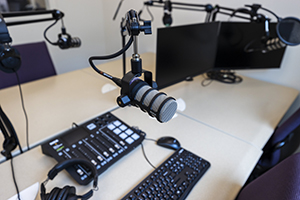Weber State Rolls Out New Digital District and is Distinguished as Adobe Creative Campus
OGDEN, Utah – Faculty, staff and students at Weber State University now have access to a suite of cutting-edge technology through the university’s ongoing Digital District project, thanks in part to CARES funds, which supported the university’s transition to online learning.
A wide array of tools are now available for faculty in Lampros Hall on the Ogden campus, including a podcast studio, mobile SMART Board TVs, technology-enhanced collaboration spaces, and an active-learning classroom. This classroom can quickly shift from  accommodating a lecture to fostering group work in high-tech pods. The work students produce in these pods can be moved onto a main screen for the whole class to see. (Tour the Digital District here.)
accommodating a lecture to fostering group work in high-tech pods. The work students produce in these pods can be moved onto a main screen for the whole class to see. (Tour the Digital District here.)
There are also individual workspaces where faculty can develop online, virtual and technologically enhanced face-to-face courses, with instructional designers and teaching experts nearby to provide assistance.
“It's meant to be a very efficient use of time and space, so faculty can come in, do what they need to do to develop a course and have all the experts right there to help them do it,” said Brenda Kowalewski, associate provost for high-impact educational experiences and faculty excellence at Weber State.
The university will hold a virtual event Tuesday, where the campus community can learn more about these new resources. At the event, Adobe leaders will announce Weber State as their newest Adobe Creative Campus, a designation given to a select group of colleges and universities around the world that are driving the future of digital literacy. Reporters are welcome to join this brief virtual announcement at about 3:50 p.m., via Zoom link, and any other sessions of the event, using session-specific Zoom links found on the event’s webpage. (Registration is required for these sessions.)
Jason Barrett-Fox, assistant professor of rhetoric and writing studies, will also be recognized as a Faculty Fellow. As a fellow, Barrett-Fox will share techniques with fellows from other colleges and universities, focusing on how he has integrated Adobe tools into his first-year composition courses at Weber State.
 “Adobe applications help composition students generate polished, vivid research writing and translate it into other media, from digital magazines to documentary video,” Barrett-Fox said. “They can then share that writing with audiences in ways that were unimaginable two decades ago. These technologies of invention and distribution imbue college writing with new energy and significance.”
“Adobe applications help composition students generate polished, vivid research writing and translate it into other media, from digital magazines to documentary video,” Barrett-Fox said. “They can then share that writing with audiences in ways that were unimaginable two decades ago. These technologies of invention and distribution imbue college writing with new energy and significance.”
Barrett-Fox’s approach allows first-year students to build foundational digital skills that they can further develop in future courses, Kowalewski said, and this digital skill set will give them an edge in the job market when they graduate.
“Digital literacy and fluency are quickly becoming core competencies for employment opportunities on an international scale,” said Liz Arias, Sr. Customer Success Manager at Adobe. “One of the most effective ways academic institutions can ensure their students become digitally literate and fluent before they enter the competitive workforce is through early and frequent exposure to creative tools.”
Progress on the Digital District was expedited due to the COVID-19 pandemic, which brought a rapid shift to online learning. An infusion of CARES funding enabled the project to move forward ahead of schedule, providing additional support to faculty.
“We already had envisioned this digital district and done years of planning,” Kowalewski said. “When the pandemic hit, we had all of our plans in place and could leverage the CARES funding that came our way for this very purpose, because much of it was meant for technology and for moving courses to online and virtual format.”
 The Digital District expands existing resources, such as Creative Academic Technology Solutions in Lampros Hall, which supports faculty in recording lectures or creating technology-enhanced teaching tools for their courses, Kowalewski said. Before the pandemic, the CATS team completed a do-it-yourself media production studio as one of the first components of the Digital District.
The Digital District expands existing resources, such as Creative Academic Technology Solutions in Lampros Hall, which supports faculty in recording lectures or creating technology-enhanced teaching tools for their courses, Kowalewski said. Before the pandemic, the CATS team completed a do-it-yourself media production studio as one of the first components of the Digital District.
This expansion happened just in time. Prior to the pandemic, instructional designers had smaller spaces to work with faculty. When the pandemic struck, faculty urgently needed the technology that had just been made available through the media production studio and course development spaces.
Resources for students are located right next to Lampros Hall at Stewart Library, where students can check out laptops and hot spots. They can also access an enhanced computer lab with double monitors and high-powered processors. Staff are located nearby, available to provide assistance to students when they need it. This lab opened during fall 2019, just prior to the pandemic, and it quickly became the most used computer lab on campus.
“The use of that lab just went through the roof,” Kowalewski said. “We were really pleased because it was clearly something that students wanted to keep coming back to — not just because of the nice technology in the space but because of the support services that were available for them there.”
For more news about Weber State University, visit weber.edu/wsutoday.
For photos, click on this link.
Hashtags, #EverUpwardAtWeber #AdobeEDU #creativecampus
Megan Olsen, Office of Marketing & Communications
801-626-7948 • meganolsen9@weber.edu- Contact:
Brenda Kowalewski, associate provost for high-impact educational experiences and faculty excellence
801-452-1395 • bkowalewski@weber.edu